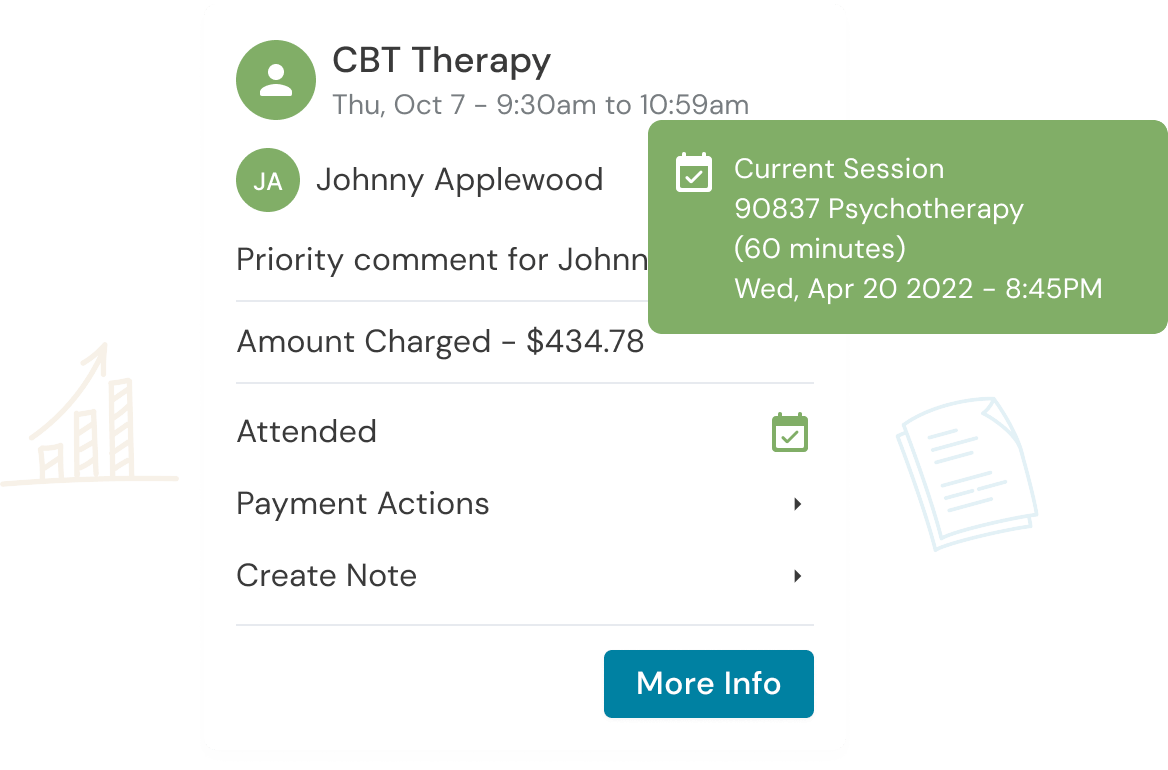You might have noticed that some things are more expensive this year than last – rent, utilities, food. As our daily expenses inflate, for therapists in private practice, session rates may need to rise to meet them. Even though your business is one that helps others, you can only help your clients if you can keep the lights on. In this view, increasing session rates can be seen as a natural and expected process, key to running a business that supports your clients and yourself.
With many folks experiencing financial hardships related to the pandemic, it might seem daunting to think about raising rates now. But there is a way to do so with empathy and intentionality: read on for suggested questions to ask yourself before raising your rates, and how to approach the conversation with your clients.

1. Understand the reasons to raise your fees
(1) To keep up with inflation
Inflation generally trends upwards at a rate of 3% each year. This means that the costs of goods or utilities are, on average, 3% more expensive this year than last year. So, if you’re not at least increasing your rates by 3% per year, the same dollar amount that you are earning this year has less “value” than what you earned last year. In order to keep up with inflation rates, you need to raise your session fees to earn the exact same “purchasing power” as years prior.
(2) To take care of yourself
You need to take good care of yourself first and foremost. If you’re worried about how much money is in your bank account, you will likely question paying for things like a marketing budget or a new coffee machine. Those fears will affect the quality of your work with clients and may even lead to burnout if prolonged. In order to maintain your business (and your compassion!), it’s important to ensure that your top employee (you) is comfortable.
(3) To match your increased experience
With more time under your belt as a therapist, you’ve become more experienced by working with more clients and being on cases for longer periods of time.
You may have even gained new skills or attended trainings that you bring into your practice, such as Eye Movement Desensitization and Reprocessing (EMDR) therapy or yoga teacher training. This means that your services are worth more, and should be compensated accordingly!
(4) To invest in training and create protective time
By raising your therapy rates, your budget will look different. You may now have room in your budget for things like additional certifications or trainings, which can directly add value for your clients.
If you decide to raise your rates but see fewer clients (with your budget staying the same), you’ll have more time for yourself, which can be an important protective factor against burnout and lead to longevity for your practice.
2. Overcome your fear, guilt, and self-worth doubts
Even with the mindset of raising rates as a strategic business decision, the act of charging your clients more might bring up difficult feelings, such as fear of losing clients, guilt of asking more from your clients, and/or questions about your self-worth. These are common reactions, so you certainly aren’t alone.
Because your businesses directly impact people’s lives, it’s hard to take their feelings out of the equation.
Overcoming your fears
Here are two prime examples of common fears when raising therapy rates and how to reframe and move past them:
- What if my current clients leave me? By asking more from your clients – people that you’ve connected with, built rapport with, and likely enjoy working with – you might be afraid that they will reject your increased rate and decide to terminate on the basis of cost. Being intentional in your communication and transparent with your clients can help you avoid these fears; read on below for more on this.
- What if I can’t fill my caseload at this fee? An important part of assessing session fees is understanding your market rate: use this fee setting calculator to determine where your fees fall relative to other providers near you. If you raise fees incrementally and with intentionality, your rates will likely remain within the average range of therapy costs, and you will still find clients willing to pay for your service. Raising your fees is also a great chance to reevaluate your marketing and what you’re putting out into the universe. Does your web presence feel like that of a $250 per session therapist? If not, it may be time to reevaluate your marketing, which you now have the opportunity to do because of your increased income.
Overcoming your guilt
Another common feeling associated with money is guilt. Considering that your private practice is a business might help you reframe this guilt and allow you to take care of yourself. Here are two examples of how guilt might show up – and how to deal with it:
- I feel bad charging so much to my clients. Raising your fees is more about your business than it is the clients – it’s not personal and you shouldn’t feel like it is! Running your own private practice means that you must make strategic decisions for the sustainability of your work. It would be more detrimental to your clients if you had to close your private practice because you can’t cover your costs than asking them to pay a marginal amount more each session.
- My clients are struggling financially, and I feel bad asking them for more. There are options here, which we will cover in Step #4. You can always consider staggering your fee increases or delay the increases for those clients you know have financial difficulty.
Overcoming doubts about your self-worth
Lastly, reflections on your self-worth may come up when considering to raise your therapy rates. Take this as an opportunity to do some self-worth work and appreciate what you offer clients. Here are two doubts regarding self-worth that may arise and some ways to reframe:
- Are my services really worth this much? I can’t even afford my own services! Think of how many people you’ve helped throughout your career. Was there a client recently with a life changing outcome? What impact has your work had on your clients’ families, friends, careers? The work you’ve done is amazing and immeasurable – use this to acknowledge that your services have priceless value.
- What will my colleagues think of my higher fees? Even though you have an independent practice, it doesn’t mean that you are in a bubble – your peers will likely find out about your raised rates. However, they’re likely raising their rates too, if they’re savvy in business! Withhold your perceptions of peer judgement and know that every practice and therapist different, and you are setting your business up to help clients to the best of your ability – and there’s absolutely nothing wrong with that.
3. Determine by how much you’ll raise your fees
Suddenly drastically increasing your fees could make it difficult for your clients and can come as a shock to them. Given inflation is 3% (and if you were working a corporate job, a standard raise would be 3% on the low end and 10% on the high end), you might consider an approximately 5% increase in your fees per year.
Not a fan of math? No worries: here are some sample fees and equivalent 5% increases!
- $100 per session → $5 increase → $105 per session
- $150 per session → $7.50 increase → $157.50 per session
- $175 per session → $8.75 increase → $183.75 per session
- $200 per session → $10 increase → $210 per session
Of course, the 5% figure is only a guide — increasing your fee by an amount like “$8.75” can feel like a random figure to clients, and a $10 increase can feel large for some clients. If this is the case, you might choose to increase your fees by $5 to start with. If your current sessions are $150 and you consistently increase your fee by $5 per session each year, you will be at $175 per season in five years and $200 per session in ten years. Consider if this rate of fee increase resonates and feels good to you!
4. Consider staggering fee increases: new clients first, financially struggling clients last
In your practice, you likely have a few different groups of clients: new clients, existing clients who can afford an increase, existing clients who are on sliding scales, existing clients who wouldn’t be able to afford your higher fees, and returning clients.
Consider the following when communicating your new fees with each of these client groups:
- New clients. This group has no past knowledge of your fees, so you can start from scratch. Put your current fees aside, and imagine you’re starting a brand new private practice with your current level of experience and expertise. How much would you deem your sessions worth? Maybe you’ve been charging $150 per session for the past five years but you’ve gotten trained in multiple new modalities since. If you still feel hesitant about such a large jump (for example, for fear of slowed referrals), you could always use fee ranges to your advantage. For example, instead of just listing $190 per session, you might list $175 – $190 per session. This way, you’re still charging more than your current $150 per session, but you’re also offering the potential for clients who can only afford $175 per session to reach out to you. As you gain confidence in referrals, you can reduce or eliminate the fee range.
- Existing clients who can afford an increase. These are clients who are paying the full fee. If they have good out-of-network benefits, an increase of $5 or $10 may not even affect their out of pocket fees, which makes the decision simple. Giving this group 90 days notice might be helpful to prepare them (and their budgets, if impacted) for the increased rate, which also creates time for conversations about what the increase means to you or them if necessary.
- Existing clients who can’t afford an increase. This group is made up of clients who are on sliding scales already or those who raise financial trouble in their sessions as a recurrent topic. For this group, increasing their rate by $5 a session still may not break the bank – that’s the price of a coffee or snack. And if they absolutely can’t afford an increase, you can always choose not to do so for them.
- Returning clients. If a client terminated before your increase, and then decides to return to therapy with you, you can start fresh by establishing them at the new rate.
Each of these groups may require a different way of communicating the increased rate, which we will discuss in the next step.
5. Mentally prepare to share this change with your clients
To ensure that you’re being intentional and thoughtful about raising your therapy rates, prepare how you’ll share these changes with your clients. Remind yourself to put away your fear, guilt, or negative self-talk and focus on communicating in a clear, compassionate way.
Here are some ideas on framing and navigating the conversation:
- Express gratitude and show consideration: “I’ve really enjoyed working with you, and I appreciate that you come see me each week. I think that you’ve made a lot of progress, and I want to make sure that you reach your therapy goals. As part of my regular practice evaluation and update, I’m going to be increasing my therapy session fees starting on [Date] to $[Amount]. This increase is certainly not personal, and I wanted to give you three months notice so that we could discuss it, and allow for space for any questions you may have. How can we make this change feel more comfortable for you?”
- Be transparent with your rationale: “To keep up with the current inflation rate, I need to make sure my session fees are at a rate that allow me to keep my practice going – and that means a slight increase across my practice.”
- Relate to client financial struggles, and emphasize your willingness to discuss the change: “I know that you’ve shared with me some financial stress that you are experiencing. I can certainly appreciate that and relate; managing money is difficult! I’d like to make this work for you, while also ensuring my practice can continue in a sustainable way. Would you be open to discussing a timeline and options that could work for you?”
6. Confirm what you discussed in writing via email
After you’ve verbally told your clients about the raise in therapy rates, send them an email that restates the upcoming changes. This ensures that you have all of your bases covered and that the increased fee is communicated clearly.
You may have to refer clients out, in the event that the increased rate is too much for them. Keep in mind that this isn’t personal and be ready to provide the appropriate support.
7. Update your listed fees across necessary platforms
Once you’re ready to officially charge more for your sessions, be sure to update all of the written information about your practice, including:
- Your website
- All online therapy directory profiles (including Zencare!)
- Your intake paperwork
- Invoices and payment systems
- Your email templates or responses
8. Up your marketing game
As a final step, place value on your marketing game — there’s a reason you’re increasing your rates. You are more experienced, have deeper knowledge, have fine-tuned your skills, and are ready to take on your next case! While you know that, prospective clients might not. Make sure that your marketing reflects who you are and what you have to offer.
Evaluate the language you use in your marketing. What does it say about you as a therapist or about your practice? List out your therapy approaches and your credentials: does this language make your services stand out as high quality? Adding a professional photo or an introductory video is an excellent touch and shows prospective clients that you’re savvy and worth a higher rate.
It can be scary to take these steps to raise fees, but always remember that you work hard and deserve to get compensated accordingly. Your practice is important not only to you but to those you support. Making sure that you’re comfortable financially and that you’re being fair to yourself and what your services are worth is a great goal, and being thoughtful and empathetic about how you do this just speaks towards your professionalism and dedication to helping your community grow their wellness.

Get paid with Owl Practice.
Reduce clinical administrative tasks and transform more lives with Owl Practice. Owl Practice provides all the tools you need to make your practice successful. Join the thousands of care professionals using Owl to run their practice every day.



